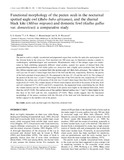| dc.contributor.author | Kiama, S G. | |
| dc.contributor.author | Maina, J. N. | |
| dc.contributor.author | Bhattacharjee | |
| dc.contributor.author | Weyrauch, K. D. | |
| dc.date.accessioned | 2013-07-24T08:45:45Z | |
| dc.date.available | 2013-07-24T08:45:45Z | |
| dc.date.issued | 2006-02 | |
| dc.identifier.citation | S G. Kiama, JN Maina,Bhattacharjee ,Weyrauch, K. D,2006 Functional morphology of the pecten oculi in the nocturnal spotted eagle owl (Bubo bubo africanus), and the diurnal black kite (Milvus migrans) and domestic fowl (Gallus gallus var. domesticus): a comparative study, | en |
| dc.identifier.uri | http://onlinelibrary.wiley.com/doi/10.1017/S0952836901001029/abstract | |
| dc.identifier.uri | http://erepository.uonbi.ac.ke:8080/xmlui/handle/123456789/50575 | |
| dc.description.abstract | the pecten oculi is a highly vascularized and pigmented organ that overlies the optic disc and projects into the vitreous body in the avian eye. First reported over 300 years ago, its function(s) remains a puzzle to ornithologists, ophthalmologists and anatomists. Morphometric study of this unique organ was undertaken in birds exhibiting apparently different visual acuities, namely two species of diurnal birds (the ground-dwelling domestic fowl Gallus gallus var. domesticus and a highly active predator bird, the black kite (Milvus migrans) and a nocturnal bird (the spotted-eagle owl Bubo bubo africanus). The volume of the owl's eye was 4.8 and 2.2 times larger than that of the fowl and the kite, respectively. However, the pecten of the fowl consisted of more pleats (16–18) compared to the kite (12–13) and the owl (5–6). The volume of the pecten of the kite was 1.4 and 2.7 times larger than that of the fowl and the owl, respectively (P < 0.05). Similarly, the surface area of the pecten of the kite was 2.6 and 4 times larger than that of the fowl and owl, respectively (P < 0.05). The volume density of blood vessels (lumen and wall) in the pecten of the kite, fowl and owl comprised 67.7%, 66.9% and 62.6%, respectively, the pigmented tissue constituting the rest. Both the volume density and the volume of the blood in the pecten were higher in the diurnal birds (kite, fowl) than the owl (P < 0.05). The surface area of the capillary luminal surface was 1.7 and 5.3 times higher in the kite than in the fowl and the owl, respectively (P < 0.05). These results suggest that the functional morphology of the pecten correlates with the life-style of the bird and with functional need, and lends further support to the nutritive role of the pecten. | en |
| dc.language.iso | en | en |
| dc.publisher | University of Nairobi, | en |
| dc.subject | pecten oculi; | en |
| dc.subject | spotted eagle owl | en |
| dc.subject | black kite | en |
| dc.subject | domestic fowl | en |
| dc.title | Functional morphology of the pecten oculi in the nocturnal spotted eagle owl (Bubo bubo africanus), and the diurnal black kite (Milvus migrans) and domestic fowl (Gallus gallus var. domesticus | en |
| dc.type | Article | en |
| local.publisher | college of agriculture and veterinary services, | en |

